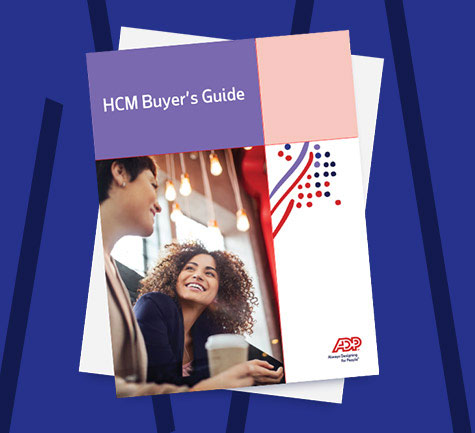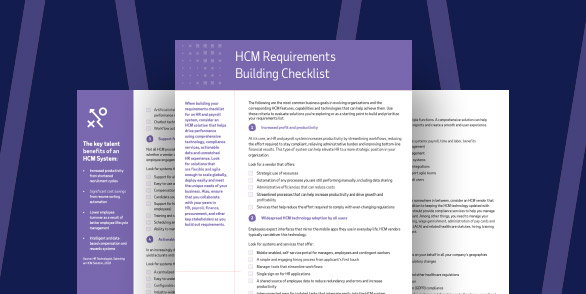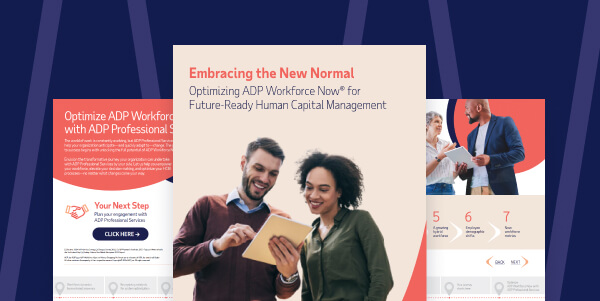Successfully managing a workforce in today’s complex business environment requires more than having the latest technology platform. It also takes strategic human capital management (HCM) and integrated, end-to-end solutions. In other words, HR professionals must connect the dots between technology, people, business objectives and client satisfaction.
Table of Contents
What is strategic human capital management (HCM)?
If an HCM solution is a toolbox, then HCM strategy is the blueprint for how an organization plans to manage and support its employees. The two work hand-in-hand to deliver the following
- Smoother processes – simplifying workflows and reducing manual tasks
- Employee support – enabling employees to manage their own information and engage with the organization
- Data insights –providing data for tracking performance and making informed decisions
- Compliance ease – helping stay on the right side of regulations while minimizing paperwork
Important components of human capital management strategies
Designing HCM strategies to accommodate organizational change, improve employee engagement and retention, and support business objectives requires two essential components – expertise and technology.
Cutting-edge HCM technology
A comprehensive HCM solution that includes HR, payroll, talent, time and attendance, and benefits administration delivers:
- An end-to-end system with increased control, visibility and productivity – far beyond what disparate HR platforms can provide
- Integration with finance, which is important as HR becomes more strategic in an organization
- Advanced HR analytics to extract insight from data and use it to inform critical business decisions
- A user-friendly employee self-service portal to reduce time-consuming, repetitive queries
Expertise beyond the technology
Freed from administrative burdens by the technology, employers and HR professionals can shift their focus to strategic initiatives, such as:
- Improving engagement, which can be key to retention in tight labor markets.
- Shaping culture in a world where company values, meaningful work and a clear career path are becoming as important as compensation and benefits.
- Redesigning the organization and adapting to “liquid workforces” focused on projects, not roles.
- Harnessing the power of big data, using people analytics to gain insights and make informed business decisions.
- Embracing the digital revolution and deploying integrated HR solutions that cover the career spectrum, from recruitment to retirement.
- Making people change-ready and adaptable through a program of ongoing training.
Benefits of strategic human capital management
Strategic HCM has the potential to transform HR at midsized organizations, helping them solve key challenges in talent, engagement and workforce management. More specifically, employers who transition from tactical to strategic HR may be able to:
- Support compliance with legislation in a timely manner, no matter how often it changes.
- Meet the radically different needs and expectations of a multigenerational workforce.
- Build a culture that embraces familiar technology, e.g., mobile, to empower people.
- Adapt to shifting workforce patterns and improve retention through constant engagement.
- Align HR with business objectives and deliver return on investment (ROI).
Types of HCM strategies
Some leading providers of HCM solutions, like ADP, offer strategic advisory services to help employers execute their human capital strategies and make the most of their technology investment. This offering encompasses the following areas:
- Benefits and total rewards
Tailor benefits to employee needs and the business and regulatory environment to maximize retention and minimize cost. - Change management and communications
Develop and deploy communications to address organizational changes, such as mergers, acquisitions and rapid growth. - HR strategy and management
Evaluate how to stay relevant, improve productivity and profitability, and get tools to help measure the impact. - Compliance and regulatory affairs
Understand federal, state and local requirements and help mitigate risks to avoid costly penalties resulting from non-compliance. - Workforce strategy
Identify and assess the impact on policies, processes, people, technology and risk. - Talent strategy
Align and optimize technology to create a holistic strategy that attracts, retains and develops employees. - HR service delivery and performance metrics
Analyze which HR functions are working well and where improvements need to be made. - Global payroll and service delivery
Create global payroll strategies and governance frameworks customized to organizational needs. - People analytics strategy
Interpret and validate data, and then use it to make decisions, tell a story and shape the future of the business. - Process optimization
Assess whether existing processes are operating efficiently and if resources can be repurposed without compromising quality or stakeholder satisfaction.
Best practices for implementing a human capital strategy framework
Driving value from an HCM strategy requires collaboration between chief human resource officers (CHROs) and other members of the executive team or C-suite. As a team, they must define the challenges facing their organization, clarify their respective roles and integrate customer feedback.
Identifying challenges
HCM challenges tend to vary according to industry, organizational goals, and other factors. However, some of the more common examples include:
- Maintaining employee engagement
- Leadership development
- Competitive total compensation packages
- Retaining top performers
Clarify executive roles
HR leaders can drive performance and improve processes by assigning each executive a role within the rollout of the HCM strategy. Responsibilities by title might look something like the following:
- Chief executive officer (CEO): Lends strategic support
- Chief financial officer (CFO): Provides details on the financial and human resources necessary for HCM project execution
- Chief technical officer (CTO): Certifies the technical and compliance aspects of effective HCM implementation
- Chief marketing officer (CMO): Spearheads internal and external HCM communications
Integrate customer feedback
Ultimately, the focus of C-level efforts to improve HCM should extend beyond the organization’s walls and consider customers. Integrating their feedback into the strategy can help maximize the potential of HCM solutions for improving client satisfaction.
Frequently asked questions about human capital management strategy
Why does strategic HCM matter?
Strategic HCM connects people, technology and data, which puts HR professionals in a unique position to:
- Explore and understand workforce trends and connections
- Monitor regulatory and legislative changes
- Advise on new policies and their impacts
- Know what employees need and want and the challenges they are facing
- Explore how people issues affect the bottom line
- Solve problems in sensible and practical ways
What is the difference between HR and strategic HR?
Traditional HR tends to be transactional and focuses on payroll processing, administering benefits and tracking time and attendance. Strategic HR, in contrast, involves looking at the bigger picture and using data, technology and principles of inclusion and wellness to make a difference for an organization’s people and bottom line.
This HCM guide is intended to be used as a starting point in analyzing strategic HCM and is not a comprehensive resource of requirements. It offers practical information concerning the subject matter and is provided with the understanding that ADP is not rendering legal or tax guidance or other professional services. Please consult with your legal counsel.




